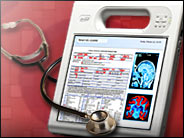S'pore hospital to use tablet-like PC

SINGAPORE--A local hospital will be the first in the world to use a new mobile device offering patient information on-the-go in an Accident and Emergency (A&E) environment.
Changi General Hospital (CGH), part of the Singapore Health Services (SingHealth) group, is one of three hospitals worldwide to conduct a pilot trial of the Mobile Clinical Assistant (MCA), and will be the first hospital to implement it in the A&E department, said CGH CEO T.K. Udairam during a media briefing Thursday.
Developed by Intel, the MCA is described as a lightweight, spill- and drop-tolerant mobile device that allows doctors and nurses to access patient data such as lab results and medical histories, while on the move.
 |
Dr. Goh Siang Hiong, chief of CGH's A&E department, said the hospital has not been able to find a suitable mobile hardware platform--until now.
The MCA is touted as the ideal mobile device for a hospital environment because it is lighter and sports longer battery life than a conventional tablet PC. Its 10-inch display also makes it a better candidate than the smaller PDA (personal digital assistant) form factor, said Goh.
Weighing about three pounds, the new device offers between three and four hours' battery life, "which is more than adequate", he added. "We've looked at tablet PCs but the problem is tablet PCs are heavy and they have short battery life," said Goh. "[The MCA] is a compromise between a full-scale tablet PC and PDA."
Doctors and nurses involved in the two-week trial, held in November 2006, gave the MCA a thumbs-up.
Goh said that by accessing medical records in real-time using the MCA, he was able to spend more time interacting with patients as he was no longer confined to the desktop workstation. He also welcomed the handwriting input feature as the stylus allowed him to maintain eye contact with the patient while he records the information down on the device.
On average, CGH's A&E department sees 380 patients per day, with each doctor attending to as many as 30 patients. Last year, the department saw more than 139,000 patients.
"The A&E has become busier, so the question was how we could make information easily available," Udairam said. "Doctors also need mobility as they're always moving from trolley to trolley."
Doctors and nurses at Changi General Hospital's A&E department read a patient's medical history at the bedside without having to go back to their desks. |
Udairam declined to reveal how much the hospital has invested in the MCA project, saying only that each device is expected to cost "no more than a tablet PC". The new devices will be manufactured by US-based Motion Computing, which makes tablet PCs for the mobile workforce.
CGH has ordered 12 MCA devices, and is targeting to complete the implementation by the end of the third quarter this year.
Udairam underscored IT's important role in healthcare services, and said that the hospital's annual IT budget is about S$5 million (US$3.3 million).
Fong Choon Khin, group technology officer of SingHealth, said his team is working with clinicians at other healthcare institutions to identify relevant usage areas.
The other two hospitals that have piloted the MCA are El Camino Hospital in Northern California and Salford Royal NHS Foundation Trust in the United Kingdom.